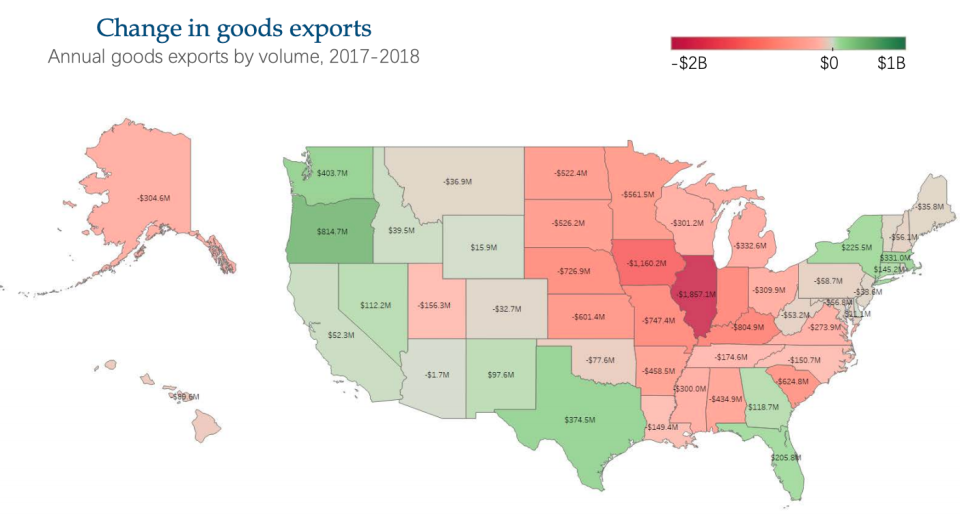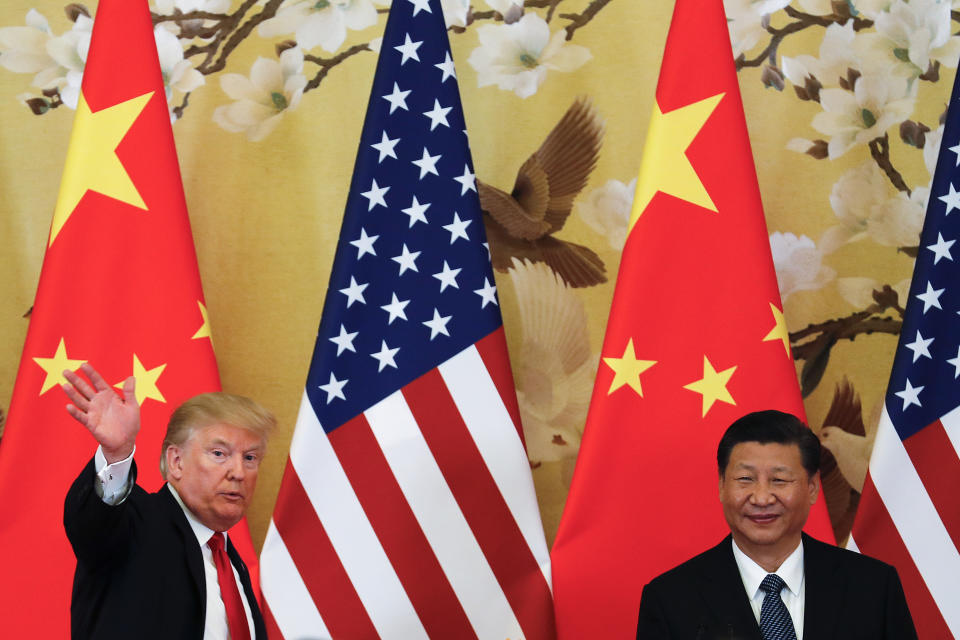Trade war damage is 'more significant than most Americans ever realized'
The U.S.-China trade war has dealt heavy blows to the American economy, and President Trump has indicated that the U.S. will not back down.
Yet as the tensions between the two countries carry on and the tit-for-tat tariffs continue, the economic consequences are apparent in various sectors across the U.S., from agriculture to manufacturing to even lumber.
“Remember, we were told that the trade wars are easy to win,” Doug Barry, senior director of communications and publications for the U.S.-China Business Council (USBC), told Yahoo Finance. “That was just as they were beginning a year ago. We found that not to be true, they’re not easy to win.”
Barry added that “not only aren’t they easy to win, but the unintended costs of a trade war are far more significant than most Americans ever realized. That’s the wake-up call — when you start engaging in this kind of conflict, there doesn’t seem to be a bottom to it.”

‘China is not sitting around waiting...’
According to the USBC’s 2019 State Export Report, the U.S. saw a 7% decline in goods exported to China between 2017-2018. And 36 states exported fewer goods to China in 2018 than they did in 2017. This is likely tied to the tariffs spurred by the trade war.
Some of those states include Illinois, Iowa, Kentucky, Nebraska, Missouri, and Kansas — an overwhelming majority in the Midwest. Exports from Illinois to China were down 32.9% last year, the largest among any state. Its biggest exports were oilseeds and grains. Overall, Illinois’ exports to China accounted for 57,570 American jobs in 2017, according to the USBC report.
These are states that rely heavily on the agricultural industry, like soybeans. At one point in 2018, U.S. soybean exports to China — the biggest consumer of the product — were down 98%. To try to offset the effect of the tariffs, the USDA created its market facilitation program to dole out payments to farmers.
“The subsidies that the U.S. government is providing to farmers to make up for lost sales to China are not making up dollar for dollar for the loss,” Barry said. “So, I think one point to make clear is that they do not completely make these farmers whole. There’s still a difference between what the farmers could earn and did earn when there weren’t tariffs on their products going into China and what the U.S. government is paying them.”

And as American farmers suffer from lack of business, Chinese buyers have turned to other countries to supply their products. Brazil has become a popular spot to purchase soybeans — while U.S. soybean inventories continue to rise. And there’s no guarantee that when the trade war comes to an end, business between the U.S. and China will go back to normal.
“China is not sitting around waiting for this trade dispute to be resolved,” Barry said. “Those markets for a U.S. farmer could be gone permanently.”
He added: “Once the Chinese buyers have developed relationships with other suppliers, why should they come back to the U.S. if they can get what they need at a similar price or a lower price, as is the case now, because the competitors’ prices are lower because they’re not tariffed to the same extent that the U.S. products are tariffed?”
The impact on the U.S. consumer
Although China is only the third-largest U.S. goods export market (behind Canada and Mexico), the trade war has still had a major effect over the last year and a half.
“You have to recall that Canada and Mexico are geographically a lot closer, so shipping goods from the South and from the North into the United States is cheaper than getting them from a lot of other places,” Barry said. “Then, since the early 1980s, there has been NAFTA, which knocked the tariffs down on many, many goods that are made in the NAFTA region to almost zero. So trade drastically increased because of NAFTA, and has continued to increase during these years.”
He continued: “What’s interesting is that China is the number three trading partner, despite the fact that it’s a lot further away than the number one and number two, and also because we do not have a free trade agreement with them. What we have now is a series of tariff increases that have made our goods much more expensive to the U.S. consumer, and as a result, the volume of trade has fallen significantly, and the jobs that depend on that trade have also been affected.”

Initially, the tariffs were projected to cost consumers an average of $831 annually. However, that number surged to $2,000 per consumer annually for 2020, according to research from the National Foundation for American Policy. Overall, the cost tallies up to a total of $259.2 billion on American taxpayers.
Barry noted when it comes to tariffs, there’s one area that people aren’t looking at closely enough: The Chinese imports to the U.S. being tariffed.
“This involves a whole range of consumer goods, such as baseball caps, for example, going into Missouri,” he said. “There’s a company there in St. Louis that does baseball caps and they employ a lot of people putting on the monograms and marketing those products, shipping those products. There are several hundred jobs involved in this one company that sells baseball caps to customers around the U.S.”
He continued: “And because of the tariffs on those baseball caps, they’re finding it now that these caps are a lot more expensive and demand for them is going down. And they’ve tried to change the supply chain so that they can bring in caps that are made in countries other than China, and they’ve not been successful in finding enough of them at the same quality that they enjoyed from their Chinese supplier. And they’re very worried that the business will be damaged significantly and that they may end up having to downsize, lay off workers as well.”
The damage ‘could be permanent’
According to China Briefing, the U.S. has placed a total of $550 billion worth of tariffs on Chinese goods, while China has tariffed $185 billion worth of U.S. goods so far.
As of Sept. 23, there are still tariffs in effect on both sides and more are to come. The U.S. will increase tariffs on $250 billion worth of Chinese goods on Oct. 15, with 437 goods exempted, while China has stated they will not retaliate for now. The two sides, in the meantime, are still engaged in trade negotiations.
“Certainly, there is a chance that [the damage] could be permanent,” Barry said. “I hope that it won’t be. This is one of the reasons there’s some urgency, a lot of urgency right now, to get a good deal — not just for agricultural products, but for other products as well, that bring those tariffs down to where they were before this began. And I think we need to do that sooner than later to avoid the kinds of consequences that were maybe not anticipated when this trade war began.”
“I think the bottom line is we just need to reestablish the trust that we once had, and continue to talk to each other across a wide range of issues and try to resolve them as best we can, in a way that makes clear that the U.S. and China both, as the two largest economies in the world, have a major stake in assuring that the global international system works for the benefit of everybody,” he said.
Adriana is an associate editor for Yahoo Finance. Follow her on Twitter @adrianambells.
READ MORE:
'Is this sustainable?’: Farmers say bailouts aren’t enough in Trump’s trade war
'We’re pretty helpless': American farmers react to China's latest trade war play
Read the latest financial and business news from Yahoo Finance
Follow Yahoo Finance on Twitter, Facebook, Instagram, Flipboard, SmartNews, LinkedIn, YouTube, and reddit.
